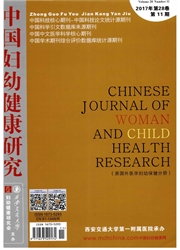

 中文摘要:
中文摘要:
目的:分析2012年浦东新区周家渡社区儿童牙齿就医的原因及其影响因素,为促进其牙病的早预防、早治疗提供参考。方法采取随机整群抽样方法对浦东新区周家渡地区765例儿童进行调查问卷,按患儿就医口腔科的原因分为主动就医组与被动就医组,就患儿的就医原因、患儿口腔卫生习惯及其家庭人口社会学基本情况进行回顾性调查。结果患儿口腔卫生习惯,家长的城郊分布,教育程度及知识结构是影响其就医口腔科原因的主要因素。城郊两地的儿童就医原因有统计学差异(χ2=13.01,P<0.05);主动就医组与被动就医组的每次刷牙持续时间存在统计学差异(χ2=4.24,P<0.05);主动就医组与被动就医组的更换牙刷的周期存在统计学差异(χ2=9.96,P<0.05);儿童就医原因和家长学历层次的分布有统计学差异(χ2=129.87,P<0.05)。结论缩小城郊差距,缩小文化程度差距,改善儿童口腔卫生习惯,做到早预防、早治疗,是儿童保健的工作重点。
 英文摘要:
英文摘要:
Objective To analyze the reasons and influencing factors of seeking medical treatment for teeth in children in Zhoujiadu community in Pudong new area in 2012, so as to provide references for early prevention and treatment .Methods A random cluster sampling method was used to carry out retrospective study .In Zhoujiadu community 765 children were surveyed with questionnaires , and they were divided into active group and passive group .The reasons for seeking medical treatment , children’s oral health habits and family population sociological features were investigated .Results Children ’ s oral health habit and parents ’ urban and rural distribution , educational level and knowledge structure were the major influencing factors of seeking medical treatment .There was significant difference in reasons for seeking medical treatment between urban and rural children (χ2 =13.01,P<0.05).Active group was significantly different from passive group in the aspects of brushing time and cycle of replacing toothbrush (χ2 value was 4.24 and 9.96, respectively, both P<0.05).Reasons for seeking medical treatment and parent ’ s education level were statistically different (χ2 =129.87,P <0.05). Conclusion The key of children ’ s health care is to narrow gap between urban and rural area , narrow educational level gap , improve children’s oral health habit, and provide early prevention and treatment .
 同期刊论文项目
同期刊论文项目
 同项目期刊论文
同项目期刊论文
 期刊信息
期刊信息
